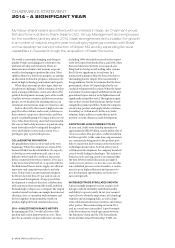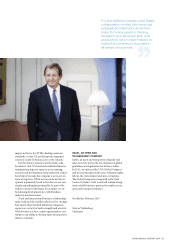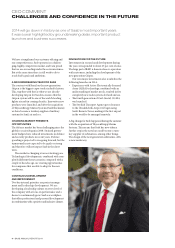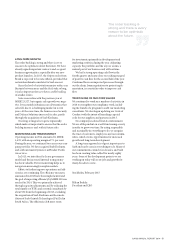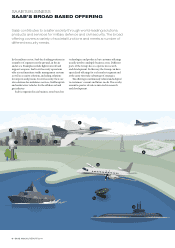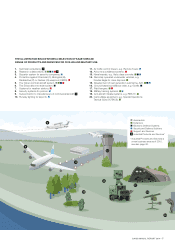Saab 2014 Annual Report Download - page 16
Download and view the complete annual report
Please find page 16 of the 2014 Saab annual report below. You can navigate through the pages in the report by either clicking on the pages listed below, or by using the keyword search tool below to find specific information within the annual report.
MARKET
MEGATRENDS
A long period of relative calm in the world may be coming to an end.
Conflicts within and between nation states could become more
common, while the influence of international institutions is on the
wane. The way in which conflicts are fought is changing as well,
largely driven by technological developments.
Over the long term, Saab and the rest of the
defence industry asa whole are aected to a high
degree by geopolitical and economic develop-
ments and their impact on the risk of conict. A
number of signicant changes are now underway,
two of which can be considered the most funda-
mental. e rst is a change in global security
systems. Secondly, there is a growing overlap
between protecting borders and defending public
services and therefore between the military and
civilian sectors.
GEOPOLITICAL SHIFT
e old world order was built on the idea that
independent, sovereign and self-sustaining nation
states would create a stable balance of power, with
military might if needed. is idea dates back to
the Peace of Westphalia in 1648. Aer World War
II, it was thought that peace and prosperity could
be created with the help of a new security philo-
sophy based on shared principles. is was reected
in institutions such as the UN, and later the EU.
When the Cold War ended 25 years ago, it laun-
ched a period in which the US became the domi-
nant power. e geopolitical and economic
balance is now being disrupted as the Asia Pacic
region, which lacks the security structures of
NATO and the EU, grows stronger. is multipolar
power structure could result in clashing interests
that challenge the geopolitical calm. Internal pres-
sures are driving nationalistic fervour in a number
of countries and, in time, domestic conicts and
terrorism could lead to multinational conicts.
DEFEND BORDERS AND PROTECT
PUBLIC SERVICES
e way conicts are fought is largely driven by
technology. e aim of traditional security policies
is to defend borders, but there is also a growing
realisation that security has to include protecting
public services such as supply chains, infrastructure
and information. It also means that the dened
line between military and civilian is gradually
being erased.
National security means making a society
robust enough to handle severe stress, at the same
time ensuring that it has the capabilities to deter an
attack. e basic idea is that in today’s high-tech
world, a country simply cannot be defended in the
old way, with strong protection everywhere.
One consequence for the industry and Saab is
that demands will change as the denition of the
defence industry is broadened. A greater risk of
conict means a higher demand for protection and
security, and companies in the defence industry
have to show that they are capable of adapting.
12 – SAAB ANNUAL REPORT 2014


